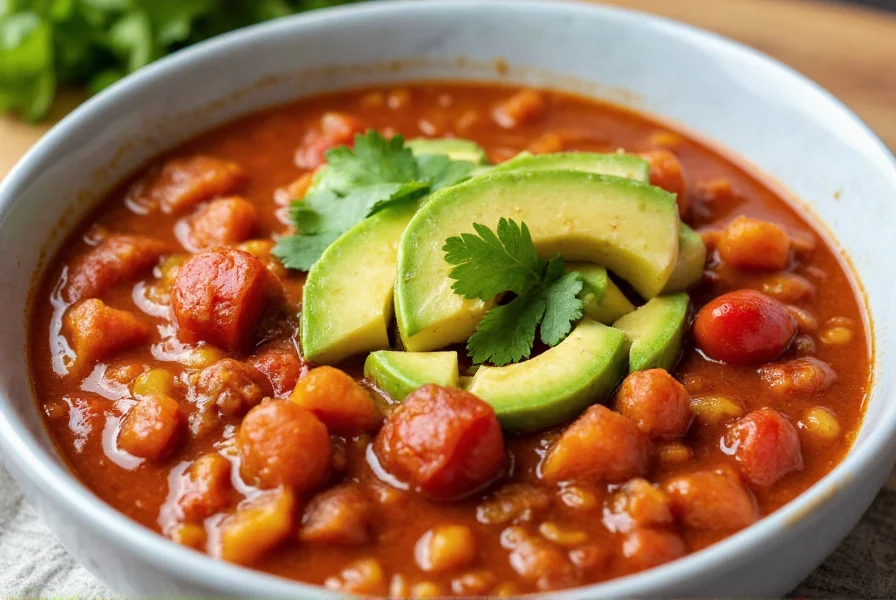Creating exceptional chili without tomatoes challenges the conventional recipe framework but opens up exciting culinary possibilities. Many people avoid tomatoes due to dietary restrictions like nightshade sensitivity, acid reflux concerns, or personal taste preferences. The key to successful tomato-free chili lies in understanding what tomatoes contribute to the dish—acidity, sweetness, umami, and body—and finding suitable replacements that maintain balance without compromising depth.
Why Choose No Tomato Chili?
Approximately 5-10% of people experience nightshade sensitivity, making traditional chili problematic. Tomatoes belong to the nightshade family along with peppers and eggplants, which can trigger inflammation in sensitive individuals. Others avoid tomatoes due to acid reflux issues, as the high acidity can exacerbate symptoms. Some simply prefer a different flavor profile that lets other ingredients shine without tomato dominance.
Flavor Foundation Alternatives
The magic of great chili happens in the flavor base. When eliminating tomatoes, focus on building complexity through these alternatives:
| Tomato Function | Effective Substitutes | Ratio Guidance |
|---|---|---|
| Acidity | Apple cider vinegar, lime juice, tamarind paste | 1-2 tbsp per batch |
| Sweetness | Roasted red peppers, sweet potatoes, carrots | 1 cup diced per batch |
| Umami | Mushroom broth, soy sauce, smoked paprika | 2-4 tbsp per batch |
| Body/Texture | Beans, lentils, masa harina, tomato-free passata | Adjust to desired thickness |
Best Tomato Substitutes for Chili
Not all tomato alternatives work equally well. Through extensive recipe testing, these substitutions deliver the most authentic chili experience without tomatoes:

Roasted Red Peppers
Canned or freshly roasted red bell peppers provide sweetness and body similar to tomatoes but without the nightshade concerns of tomatoes. Puree 1-2 cups into your chili base for rich color and subtle sweetness. This works particularly well in nightshade-free chili alternatives when using only red bell peppers (which are milder nightshades that many sensitive individuals tolerate).
Tomatillo-Based Salsa Verde
For those who can tolerate some nightshades but not tomatoes, tomatillos offer a brilliant alternative. Their tart, herbal flavor creates a completely different but equally satisfying chili profile. Use 2 cups of salsa verde as your base for a tangy, authentic-tasting green chili.
Mushroom Broth Foundation
For the deepest umami replacement, combine mushroom broth with a tablespoon of soy sauce or tamari. The earthy notes mimic tomato's complexity while adding nutritional benefits. This forms an excellent base for vegetarian no tomato chili that satisfies even meat-eaters.
Perfecting Your Tomato-Free Chili Recipe
Follow this professional framework for guaranteed success with your tomato allergy chili recipe:
- Sauté aromatics: Cook onions, garlic, and celery in olive oil until translucent
- Add depth elements: Stir in 2 tbsp cocoa powder, 1 tbsp smoked paprika, and 1 tsp cumin
- Incorporate base: Add 4 cups of your chosen tomato substitute (roasted pepper puree, mushroom broth, etc.)
- Build texture: Add beans, lentils, or meat and simmer 45-60 minutes
- Balance flavors: Finish with 1-2 tbsp acid (vinegar or citrus) and adjust salt

Critical Flavor Balancing Tips
Without tomatoes' natural acidity, your chili may taste flat. Counter this by:
- Adding acid gradually at the end of cooking
- Using toasted spices to enhance depth
- Incorporating umami-rich ingredients like soy sauce or nutritional yeast
- Allowing proper simmering time for flavors to meld (minimum 45 minutes)
Many home cooks make the mistake of under-seasoning tomato-free chili. Remember that without tomatoes' natural saltiness, you'll likely need 25-50% more seasoning. Taste and adjust carefully throughout the cooking process.
Serving Suggestions for Tomato-Free Chili
Complement your chili without tomatoes recipe with toppings that enhance its unique profile:
- Fresh avocado slices for creaminess
- Lime wedges for brightness
- Cilantro for herbal notes
- Dairy-free cashew cream for richness
- Roasted pumpkin seeds for texture
These toppings work particularly well with how to make chili without tomato paste variations, adding layers of flavor that compensate for the missing tomato elements.
Common Mistakes to Avoid
Even experienced cooks encounter pitfalls when making tomato-free chili:
- Skipping the acid component: Without tomatoes' natural acidity, your chili will taste flat
- Over-relying on sweet substitutes: Too much sweet potato or carrot creates dessert-like chili
- Insufficient simmering time: Tomato-free versions need longer to develop complex flavors
- Under-seasoning: Tomato-free bases require more salt and spices to achieve balanced flavor











 浙公网安备
33010002000092号
浙公网安备
33010002000092号 浙B2-20120091-4
浙B2-20120091-4